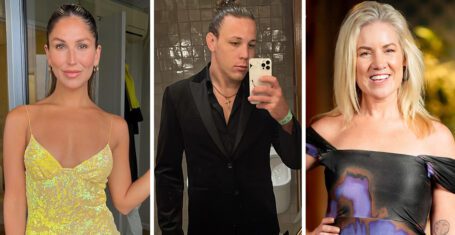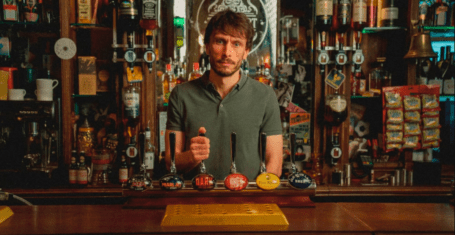
Tab Interview: Tom de Freston
JENNIFER ELLIS meets Tom de Freston in St. Peter’s Chapel to preview his new exhibition and ask him about becoming an artist, silly garments, and being crude…
Crawl up the wild path behind Kettle’s Yard and there, hidden among the trampled grass is St. Peter’s chapel; small lair for ovation and the new venue for Tom de Freston’s current exhibition. I caught up with Christ Church’s artist in residence and questioned him about becoming an artist, silly garments and crudity.
Jennifer Ellis: Hey Tom, I guess the place to start is how did you get into painting, did you always know you wanted to be a painter?
Tom de Freston: I think right up from being 14. I always had this romantic idea that I’d make art, but often these ideas change and you end up doing something else. I don’t think it was this unchanging, destined thing. But yeah, since I was fourteen. In terms of picture painting though, oh god, for six years I only painted abstract.
JE: Oh really?
TdF: Yes, right from A-Levels up to finishing my History of Art degree. I did foundation, a BA degree in Leeds, two years in Cambridge and for those six years I didn’t paint a single figure, it was all abstract – odd, and that doesn’t necessarily correlate with what my work is about. You can obviously see though in my current paintings that I did abstract at some point.
JE: By the texture you give your paint, for example, or the background you juxtapose your figures on. It’s interesting your combination of figures and abstract because, especially since the Abstract Expressionist movement completely cut out figuration. I wonder though, are you painting bodies or figures, or does it even really make a difference?
TdF: It’s one of those questions isn’t it, I could answer it from an Art Historian’s point of view, but it’s a question I would never ask myself…
JE: As an artist it never crossed your mind.
TdF: It just happens to be one of the things that I make. I don’t find myself approaching art and images from an art historian’s perspective. The analytical methods aren’t sort of necessary, that is someone else’s job. My job just involves asking what images do I want to be making and nothing else matters. So questions like whether it is a figure or a body; those are just the things that I am making.
JE: Your History of Heroism painting though makes references to other works of art. Do you think your basis in History of Art helped you do that?
TdF: I think that’s definitely more due to an awareness of the whole History of Art, but it’s also a chicken-egg scenario. I obviously did the History of Art degree at that age because I had a passion for the History of Art. So which came first? Surely some major works were included, but you have to be careful of playing that History of Art game, where you say it’s some zombie version of Michelangelo. Ideally, I’d like to create that state where not everyone engages with it people are able to so. I don’t want this work reduced to such level that within ten seconds people recognise the background and know what it’s about but at the same time I don’t want my audience to be restricted to people that are educated.
JE: Or part of some artistic intellectual elite.
TdF: Yeah I do think it’s a problem that it does tend to play those art historical games.
JE: Tell me about this ongoing contraction you seem to have in your work. On one side you have this heroic figure, then suddenly, you clothe it in what, let’s be honest, is really quite pathetic clothing ; you have given them little underwear, little socks. The result is then that each male figure is rather emasculated. What are you trying to do here, is it tragic, is it comic?
TdF: I can quickly tell you how the socks and boxers came about in that I was making these ideally staged reproductions, looking at Caravaggio’s David and Goliath, so I set up a camera and photographed either a model or myself. It didn’t have to be anyone in particular, just a young male character. I mostly just used myself though because I was there and happy to stand for two hours. I also wanted the character to be nude; this heroic, immobile person – all the very obvious things. The problem was people kept passing past my window down the street and could potentially see where the lighting was so I thought – ok, I better wear the minimum amount possible – because it looks a bit odd if you walk by and there’s somebody sitting there, naked, making photos. So I thought, if I take them with socks and boxers, I will remember what the body looks like nude and go back and do that after. But when you’re flicking through the photos, you come across something ridiculous and funny, and then I had to figure out whether it was just me having a laugh, or is there something genuinely funny there. It’s obviously saying that the little addition of that clothing makes you more aware that they’re naked and their nudity is something that emasculates them rather than gives them some grand status. It’s like you’re at a friend’s and you have their dad walk along out of the bathroom in socks and boxers – it’s nearly worse than if he walked out naked!
JE: I definitely see the ridiculous and funny, but you also have some figures that are distinctly quite erotic – explicit sexual acts or orifices. I don’t see them here in the chapel – too blasphemous?
TdF: Oh yes, we were already worried about putting 'Dr. Faustus' on in here, then the idea of having figures which are either involved in some sexual act or on a bed masturbating or with this strange orifice that looks half between a bum and a mouth… maybe it’s not the best thing.
JE: Would you say that in those paintings you are toying with our timidity?
TdF: I wouldn’t say that I am toying with prudiness, personally, but if you look to this painting…
JE: It looks like little angels are falling from the sky.
TdF: Yeah, little slightly eroticised angels. If you look, they sometimes have this circle. What I like is that it makes you think of a scream in Francis Bacon and it’s that point of utter horror –
JE: Similar to Munch’s Scream –
TdF: Yeah exactly, well, I was making these paintings that have this scream and then I was thinking – these paintings are not horrific and my characters are more pathetic; the scream looks like an anus. You can’t take either of those seriously. It’s that whole idea of the doubling; by having the sign repeated twice one obliterates the significance of the other. At the start you may find it horrific, but then you may find it comic or tragic. It’s too over the top, their suffering.
JE: Yeah. I was just noticing, you previously exhibited your work in a chapel and here you are again, exhibiting your work in another chapel. I suppose in these venues you have the figure of Christ and you also paint figures – any correlation?
TdF: The reason is a very practical one. The idea was that here I would put the studies or the preliminary works so we could tap into Kettle’s Yard. I guess the way it has evolved though is that this is completely separate from that. I then thought that if you are using a chapel you might as well make the most of it and the things that resonate with that. So you may not think of the works outside the chapel as being religious, rather spiritual, but when in the chapel, they take on that definition.
JE: Spirituality is certainly a recurring theme throughout you work, whether it’s angels falling from the sky or that other painting where a figure is falling into an abyss.
TdF: Exactly, I don’t think there is any distinction between these two kinds of work. You can say they fail, but they’re both trying to tap into something that is real and honest. They’re not cynical, they’re spiritual. Neither is it trying to play some very clever game of 'oh look, I can create two very different things'.
JE: Truth seems to be particularly captured in the 'The Lover’s Discourse' would you not say?
TdF: Yeah, I like this idea of the figure by himself on a bed. The energy need not be erotic, but he’s in some melodramatic dance regarding 'an absent other'. It’s like what Roland Barthes talks about, that anxiety felt for someone that is not there, self-pitying and obsessive. Everyone knows what it feels like – yes it’s horrible, but it’s not a noble form of suffering, is it, it’s indulgent.
JE: Entirely self-indulgent, it’s the dramatic act for an audience of one…
TdF: that no one really ever cares about. By the way, you had a point when talking about these two types of painting. It is by them not quite marrying up in their view of what it is to be human that I want people to realise that I am not lecturing them. You know it well enough for yourselves. I don’t need to say: this is what being human is like. It never deals well to say; this is the way things are. Literature can do that brilliantly.
JE: And that’s why one must be weary of the Art Critic that tell you to look at a painting ‘this way’.
TdF: Yeah, it’s not a science. There is not this ground of certainty. That’s science’s strength.
JE: While Art’s is the ability to oscillate and bring you to another world or conjure some other shade of meaning
TdF: Exactly
JE: Something that is not exactly tangible or explanatory.
TdF: Yeah, I mean its a slightly crass analogy but when I talk about art I’m always talking about painting, pretty much – but painting’s are like a glass that you can empty or fill with a range of things. Not anything goes; what you think about a work has to go with the things that are in front of you. Paintings that are excellent are those that you can get so much from, such as a Pollock, that you can keep filling and emptying it’s glass. They just keep on giving.
JE: The more possibilities the glass holds then the better. Infinity, that’s what you’re striving for.
TdF: Yep. Let me show you this one. This one probably has the most explicit art historical reference; it’s called 'Last Judgement '. If you look at the figures in the centre, they have some sort of abstractive symmetry and create this geometric pattern. They’re nearly like wall paper, strips of it. This one is inspired by Michelangelo’s late drawing of the Crucifixion where it has that hovering over and over pencil line so it nearly seems like a prayer. But when he is off the cross, it looks like someone dancing to 70’s music, that twist of the hip.
JE: These two figures in the front, it looks like they’re beckoning you to observe this wallpaper or what appears like a comical icon.
TdF: Quite, I think the success of this work is the contraposta of this figure, the twist, the body one way and then another. I wanted it pushed to the point where you nearly consider it a dance move and then the person is male. Of course that’s stupid, being surprised by male ballet dancers, but ballet, well – there is still a lot of gender projection.
JE: There’s certainly a strong dance element to your work. Having done ballet for many years and now doing contemporary dance, you come to know that freeing your body is key, but you also be able to control it. That oscillation between different states of bodily tension, you really feel it in your works.
TdF: Yeah, if you compare the figures in the 'Last Judgement' with the others, you sense that in the latter they are in motion, whereas here, they are stilled.
JE: Yes, in the other you feel the figures are plummeting and grabbing aimlessly at thin air whereas in the « Last Judgement » they look like stilled acrobats.
TdF: Right. The references here are important, but only to a certain extent. What matters is that the mechanics of the figures work.
JE: Another question I have for you is that of gender. When looking at your works I started to notice; man, man, man (not quite sure here) man, woman!
TdF: Yeah like the odd example.
JE: Is that because you use yourself as a model or because you are interested in how the man has been perceived for so many years?
TdF: I think I am really fascinated with gender depiction and the construction of image by culture. This latest image I have done is of a woman masturbating herself. Sure, I am very aware of the reclining nude, the fantasizing of gender. I have always happened though, to paint men ! I think it’s from my interest in masculinity, a tradition – that’s what I’ve always wanted to tap into. Not man to man but man to ideology – any form of ideology that sets up artist’s ground.
JE: It’s also a question of instinct too though, isn’t it? Last night I was doing a quick watercolour of what I thought was going to be sand dunes only to realise that I was making it into a female torso! I obviously know female bodies and that’s what I instinctively went for.
I think you going for the depiction of a female body in this manner though, is very interesting. In the 1970’s there was a movement break the stereotype of women in art, but it was mostly done by women themselves! So to have a man come and reshape our conception, I think that’s cool.
TdF: I guess with the woman I am following the same vein as with my men. By the image though I am objectifying them both – but then am I? I’ve not quite worked this out. There is a quality of crudity though, they’re not coy. It’s very clear what is going on.
JE: That clarity is interesting because with images of the reclining nude, you can imagine what’s going to happen next. But here, you’re actually showing that next step. Previously the art seemed R rated but you’re telling us, everyone knows, so we might as well show it.
TdF: Venus of Urbino, look at her! I was in Johann ides’ class and I out rightly said; she is masturbating. He looked over at me horrified because I made an overt confirmation of her sexuality, but he himself knows that she is. It’s funny because there’s this prudish quality; you must look at the painting for five minutes before you realise.
JE: Crudity is key. Reading the New Yorker this morning, I came across an interview with Rodarte sisters who said the worst comment they ever received was that they made « pretty clothes». This runs with the fact that no one likes to be called ‘nice’. Who wants to have their painting’s called 'pretty'? It just leaves the person on the receiving line thinking: ‘wow, well that’s vacuous’.
TdF: Yes, yes!
JE: Well, your work is most certainly anything but vacuous. Thanks Tom.
TdF: Thanks, that was thoroughly enjoyable. I hope you can hear my voice on your little device.
(And so I could.)
Photographs by Edward Queckett









































